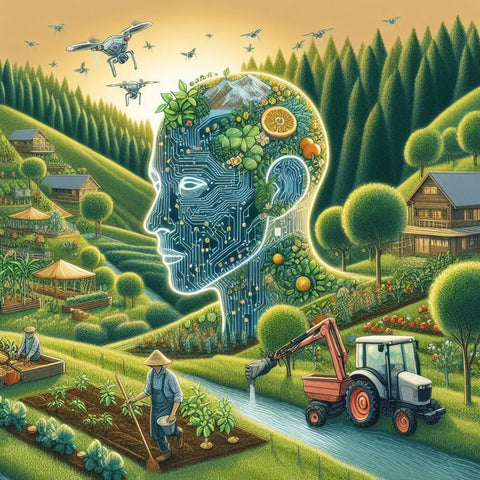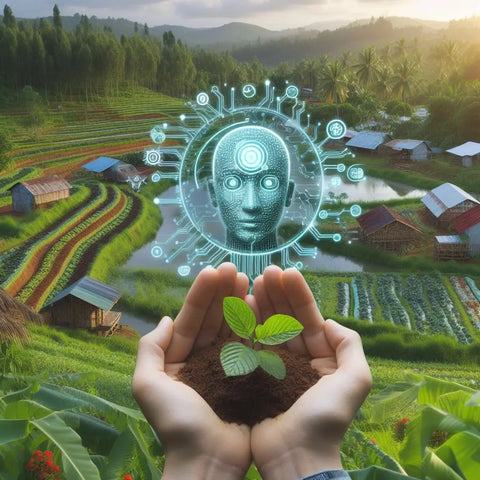The Concept of Holistic Permaculture
Role of AI in Enhancing Biodiversity within Permaculture Farms
Holistic permaculture
Holistic permaculture, as a system of ecologically friendly living, integrates the different components plants, animals, and microorganisms in a given area to provide the optimal environment for all. Permaculture is about promoting diversity in what’s at the center of it, which is the basic principle used to establish a balance and make these systems more resilient. Nevertheless, the efficient management of biodiversity on permaculture farms is a complex matter that may need a detailed plan and strong implementation. This is where AI comes into play, acts as an enabler of innovations specific to its use, and makes it all the more powerful to increase biodiversity in permaculture farms.

The Role of AI in Enhancing Biodiversity within Permaculture Farms.
AI technologies can be transformative concerning permaculture farms in the future, as they will be able to approach biodiversity management in innovative ways. Decoding the information that AI has obtained from machine learning algorithms is critical, as these algorithms make possible powerful predictive modeling and data analysis tools for the creation and upkeep of efficient, green ecosystems.
This species is an identification and counting process.
A considerable part of these jobs includes species tracking and identification, which can be done using AI. Through a blend of computer vision techniques combined with AI [artificial intelligence] algorithms, it is possible to not only efficiently identify and monitor different crop and animal species present in the farmland but also to get a comprehensive planting and census. This information in particular has enabled decision-makers to rely on facts and figures so that the environment remains as balanced and healthy as possible by keeping all species in check.
Habitat modeling and optimization (trial and error).
AI can scan massive amounts of data, such as weather trends, soil makeup, and topography, to create a perfect setting for different species. AI technology can be used to determine the particular needs of different living organisms. This will in turn facilitate the system's ability to recommend optimum planting patterns, water management procedures, and ecological interventions that can make an ecosystem flourish. It is a precautionary measure. It safeguards that the farm supports all the species, and coexistence will prevail through the design and implementation of management practices.
Pests and Diseases Management
Among the main difficulties of permaculture, agribusiness is controlling pests and diseases in a way that does not use dangerous chemicals or unsustainable practices. The position of AI in the growth of the type of biodiversity that is essentially characterized by permaculture plants entails the creation of technical tools like smart pest detection and disease surveillance systems. These systems can detect early symptoms of infestations or infections and advise ecological management measures that fit the situation, for example, promoting the foundation of natural enemies or implementing biological control methods. AI provides the core function of disease and pest limitation, which minimizes the possible disruption of the ecosystem’s fertility and biodiversity.
The use of predictive analytics and decision support systems can be a critical step in addressing homelessness.
AI predictive technologies' applicability goes beyond triggering the identification of potential threats and opportunities for farmers; it also narrows down on predicting likely pressure points or areas of exploration. Through examination of historical data, environmental factors, and the current environment, AI algorithms will pinpoint the likelihood of migration, fluctuations in population, or the emergence of new ecological viruses. Such anticipation ability is the turning point for the practice of permaculture. So the practitioners will be able to take proactive measures, adjusting planting schedules to save seeds and introducing new species to maintain balance sustainably and healthily.
IoT in agriculture facilitates real-time crop monitoring and data gathering, which has indirectly improved farm productivity.
Successful biodiversity management heavily depends on the absence of needed and up-to-date data. The role of AI in strengthening the diversity of agricultural systems within permaculture farms is to involve the installation of discovering devices, such as sensor networks and remote sensing technologies. They can create a system of data collection that can keep track of the numbers of various environmental parameters, populations of species, and ecosystem dynamics with many pieces of data; the artificial intelligence can be programmed to analyze and create actionable insights.
Challenges and Considerations
AI technology for the improvement of biodiversity within the area of permaculture adventures, but insignificant issues are hindering its implementation. Ensuring precise and reliable predictions from AI models is vital since the dangers of misdiagnosis or wrong recommendation could hurt not only the fragile communities on permaculture farms but also eat into the benefits that permaculture may be serving. Also, moralizing questions arise about the application of technical AI in ecological systems and must be addressed with great care, adhering to natural laws.

Conclusion
AI has a huge role in promoting crop diversity within permaculture farms and developing it. Through the utilization of machine learning and other sophisticated tools, AI not only gathers data but also interprets it to formulate useful recommendations that can be used to plant and sustain the economic structure of permaculture farms. From indeeding people and figuring out habitats to pest control and predictive analysis, AI offers willful solutions to deal with the complicated problems of biodiversity control.
FAQS
Whether or not artificial intelligence should be used in permaculture farms, what are the possible disadvantages or risks?
Some possible downsides may be inexact forecasting or guidance that could be caused in case the data is biased or incomplete, the possible AI covering important factors is an ecology or custom, and the danger of over-reliance on AI may bring the society out of the community knowledge and skills.
What is the mechanism for small-scale farmers to populate and customize the AI approaches to agro-biodiversity management?
There are many channels to find innovators in agtech or ecology research and development that utilize AI, as well as open-source AI, tools, and platforms, and organizations offering AI-powered solutions and consulting services for sustainable farming practices.
Biodiversity management is now asked for AI. Morally, how does AI address this?
AI systems may be developed, for instance, to adhere to ethical standards and guidelines as below: respecting natural environments, refraining from harming them, and accommodating existing ecological knowledge systems. Besides that, AI-generated suggestions can be reviewed and evaluated by experts and agents to cover their ethics and cultural values framework.





Leave a comment